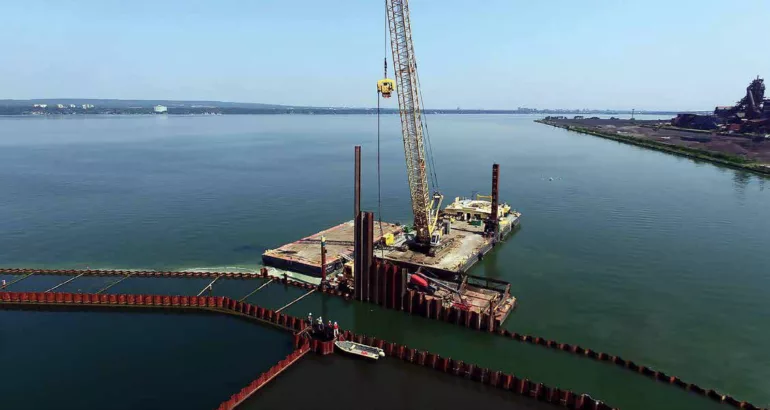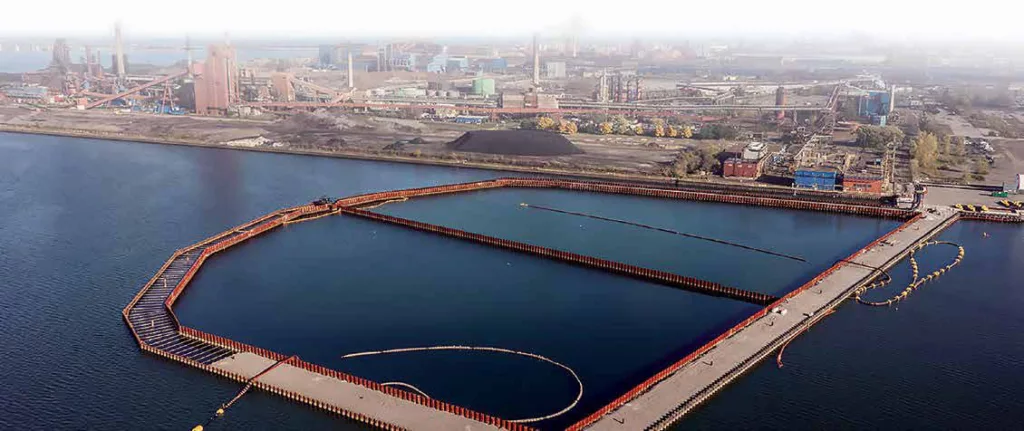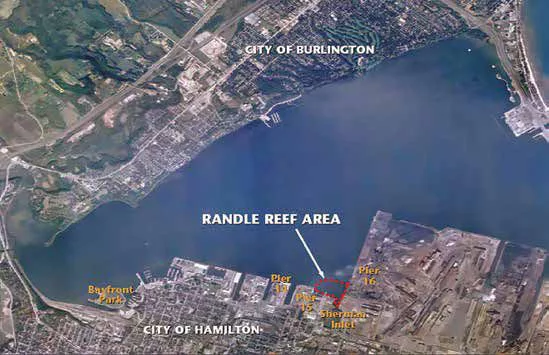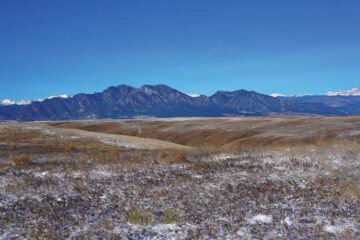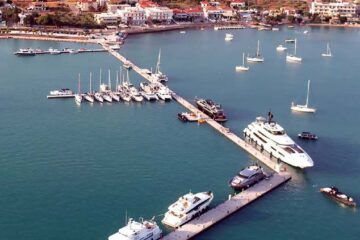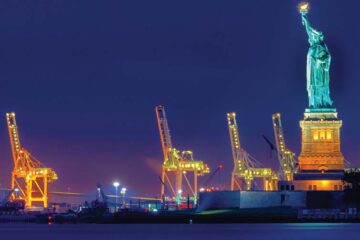Samuel Roll-Form Group was part of a team that helped entomb contaminated soil for removal in the Harbor of a Great Lakes city.
The team included Canadian civil engineering firm Riggs Engineering Ltd.; Milestone Environmental Contracting for dredging; and C3 Environmental Ltd., whose Waterloo Barrier® product was used to seal the joints of the Roll-Form steel pile.
BACKGROUND
Hamilton Harbour is home to the largest and most contaminated site within the Canadian side of the Great Lakes – Randle Reef. Hamilton Harbour is the western tip of Lake Ontario, separated naturally from the lake by a sandbar known as the Beach Strip. It is the largest naturally protected harbor on western Lake Ontario. Industry, commerce and residential areas, along with private and public open spaces share its 45-kilometer shoreline. The Harbour’s watershed covers more than 500 square kilometres and is drained by three major tributaries – Grindstone, Spencer and Red Hill creeks. The cities of Hamilton and Burlington, with a combined population of 750,000 people, are located within and around the watershed. In 1985, the Harbour was identified as an Area of Concern under the Canada–United States Great Lakes Water Quality Agreement due to significant impairment of water quality, loss of fish and wildlife habitat, and contaminated sediment and fish and wildlife populations. While many improvements have been made to reduce pollution in the Harbour, the legacy problem of contaminated sediment remains.
Located in the southwest corner of Hamilton Harbour, the Randle Reef site is approximately 60 hectares (almost 6.5 million square feet, or about 120 football fields) in size. The site contains approximately 695,000 cubic metres of sediment contaminated with polycyclic aromatic hydrocarbons (PAHs) and other toxic chemicals. It is the largest PAH-contaminated sediment site on the Canadian Great Lakes. The contamination is often described as “a spill in slow motion” due to the continuing slow spread of contaminants across the Harbour floor and uptake into the food chain of the Harbour ecosystem. PAH contamination at Randle Reef is a legacy of a variety of past industrial processes dating back to the 1800s. There were multiple sources of contamination including coal gasification, petroleum refining, steel making, municipal waste, sewage and overland drainage.
The site was identified as a principal target of Hamilton Harbour restoration objectives in the late 1980s. Studies were conducted over several years to determine possible options for cleaning up the site. In 2002, a Project Advisory Group reached an agreement to explore the idea of containing and capping the sediment. An environmental assessment, project designs, and the quest to secure funding soon followed.
ENGINEERED CONTAINMENT FACILITY (ECF)
The size and depth of the dual layered ECF constructed over the contaminated sediment in the harbor posed the most imminent challenge for the construction and engineering teams. The design of the Randle Reef ECF consists of two cells. The inner cell serves as a waterproof barrier to trap in the contaminated sediments and acts as a holding area until the contaminated water is treated. This 19,241-square meter cell is composed of 1,352 pieces of 22.5-meter long Waterloo Barrier WEZ95.
The WEZ95 was the ideal sheet piling for this project because it serves as a watertight environmental containment wall and its structural properties allow it to also serve as an anchoring wall.
The outer wall of the ECF is composed of 1,378 pieces of 27-meter plated JZ127. The 24,486 square meter outer wall of the ECF surrounds the impermeable inner cell, and acts as a structural barrier to provide additional support. Plated JZ127 was selected for this portion of the ECF because it met all engineering specifications and was able to be rolled from the provided coil.
WATERLOO BARRIER
Another aspect that made the WEZ95 the ideal sheet piling for this project was the shape of the interlock. Normal sheet piling interlocks would allow for too much water and contaminants to pass through them. Additionally, they also have an internal cavity that is too narrow to inject any sealant. Therefore, the WEZ95 offers a larger internal cavity than standard sheet piling. This allows C3 Environmental to inject their patented Waterloo Barrier System between the sheets when installed (see Figure 2). This system fills the interlocks from end to end then dries to form a cement- like sealant that makes the interlock impermeable to contaminants.
LOGISTICAL CHALLENGES
Gathering and shipping the material for a project of this size brought some logistical challenges. First, the 68,000 tons of coil required for this project was shipped to Samuel Roll-Form Group’s Iuka, Miss. mill from U.S. Steel Stelco, located in Hamilton.
Once the rolling process was complete, the 89-foot JZ127 sheet piling was moved from Roll Form Group’s facility in Iuka to Hamilton. These long pieces of material had to be loaded onto three river barges and sent up the Mississippi river system, where it arrived in Chicago. It was then transloaded onto the large lake vessel where it traveled through the Great Lakes, finally arriving in the Hamilton Harbor. The WEZ95 material was manufactured at the Roll Form Group’s facility in Cambridge, Ont., from where it was shipped to Hamilton by truck. Once on site, the sheets were installed using vibratory and impact hammers.
OVERVIEW
After the sheet piling arrived at the staging area, the ECF took almost two years to construct and dredging the contaminated sediment is expected to take several more years. After the contamination is collected and treated by a local water treatment facility, the ECF will be capped by the Hamilton Port Authority and used as an additional port facility (Bay Area Restoration Council, 2018).
Roll-Form is a division of Samuel, Son & Co., a leading metals and industrial products manufacturer, processor and distributor. Started in 1855 in Toronto, the company is still family owned and headquartered in the Toronto area.
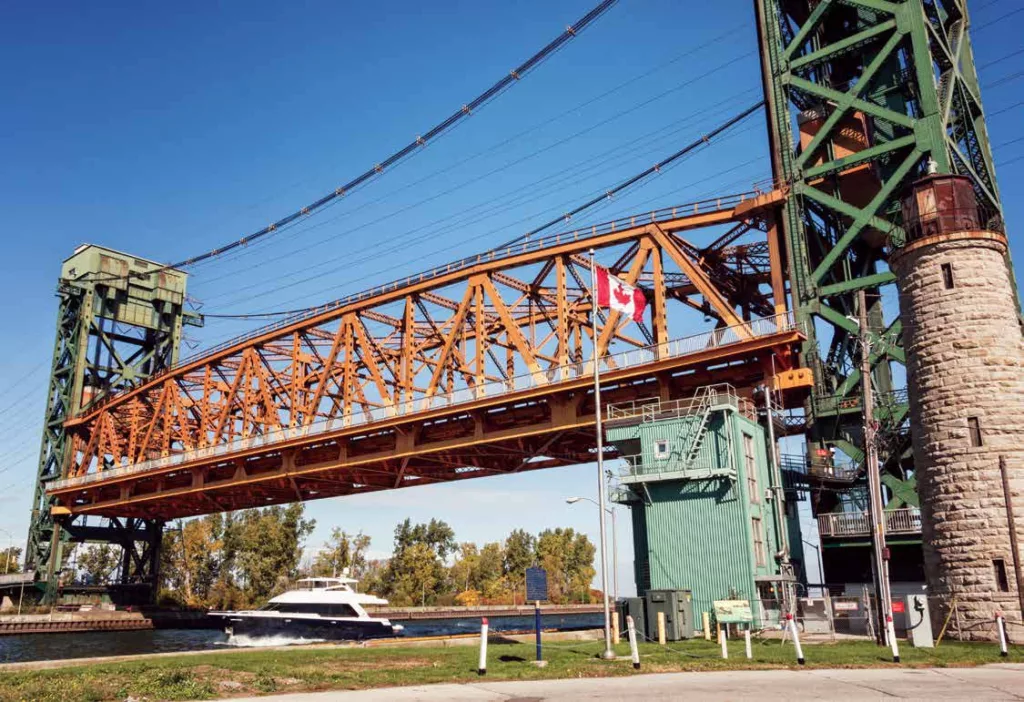
For more information about Samuel Roll-Form Group, visit www.samuel-roll-form-group.com.
Republished from Marine Construction Magazine Issue V, 2022






